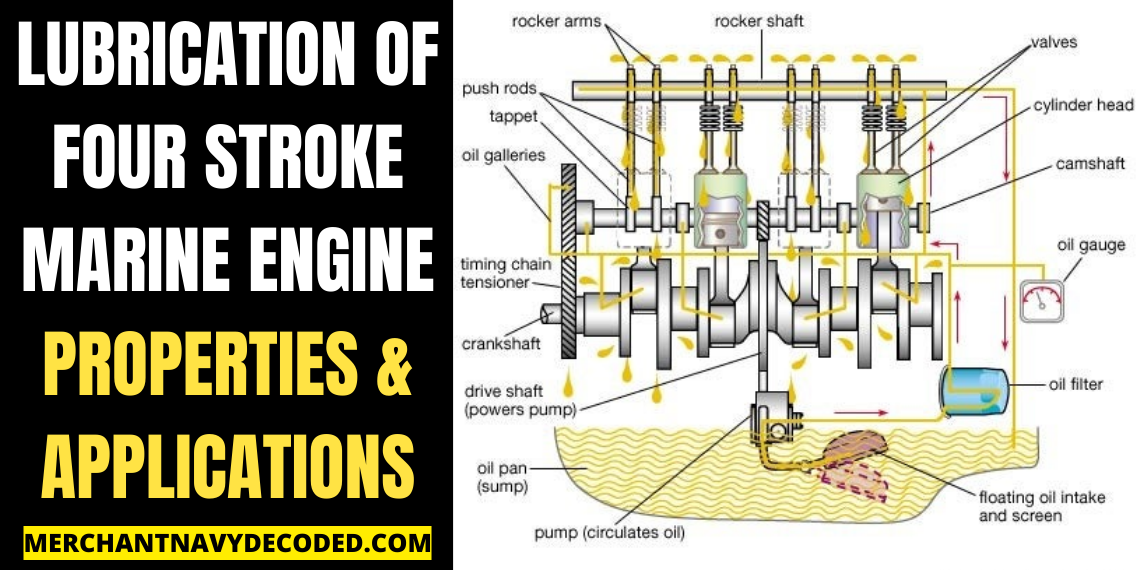Lubrication of Four Stroke Marine Engine Properties & Applications
Explain the components and working of a four-stroke marine engine lubrication system.

Auxiliary Engine Sump
This is located at the bottom of the engine bay. It collects, stores and redistributes the lube oil throughout the engine parts which are in need of lubrication. The lube oil that is stored in a 4 stroke engine sump usually has a TBN of 40.
Lube Oil Pump
On the crankshaft a gear pump is attached, so when the crank starts rotating it also rotates the gear pump which uses suction to carry the lube oil from the sump to different parts of the engine.
Lube Oil Filter
Old or dirty oil can contain impurities that can cause damage to the engine’s bearings, crankshaft, and other moving parts. So it must be filtered using the lube oil filter and this filter must be changed periodically as all the impurities will start to accumulate
Lube Oil Cooler
One of the key functions of the lubrication system is to keep the engine’s components cool. The oil cooler helps in dissipating the heat generated during the internal combustion process, which prolongs the life of the engine.
Working
There is only one type of lube oil used here to lubricate the cylinder linings and other parts of the system, unlike a Main Engine lubrication system. When the engine starts running the gear attached to the shaft will start rotating which acts as a driver for the gear pump which is used to distribute lube oil throughout the system.
The lube oil after passing through the cooler will go to all the main bearings and will also go towards the rocker arm assembly. While lubricating the rocker arm the lube oil will also go onto the camshaft lubricating it and falling back down into the sump.
There is a hole in the shaft where the main bearing is attached so that the lube oil can enter through here and travel throughout the crankshaft. Through the crankshaft the lube oil also reaches the crankpin and also travels upwards towards the piston to lubricate the gudgeon pin.

The cylinder liner is lubricated using a different method called Splash Lubrication. When the crank web goes down during rotation it touches the oil in the sump causing it to splash, and the lube oil reaches the lining of the cylinder.
There are oil scraper rings on the sides of the piston whose function is to scrape down the remaining oil in the cylinder lining back into the sump.
Why is the lube oil of TBN 40 used in four-stroke marine engines?
The TBN of lube oil is not too high or too low because the combustion air produced in the cylinder is lower therefore the presence of SOx will also be lower so there is no need for a lube oil with higher TBN. But since there is no stuffing box present, the combustible gas has a chance to mix with the lube oil in the sump and produce SOx so TBN can’t be very low either.
Note:
If you want to learn more about this topic, we suggest checking out our Combo package with the given link https://www.merchantnavydecoded.com/courses/c/ . It’s a great way to dive deeper into the subject through video explanations. This package covers all the important details and presents them in an easy-to-understand format. Watching the videos will help you grasp the topic better and make learning more enjoyable. So, we highly recommend giving our Combo package a try to enhance your knowledge on the subject.
Disclaimer :- The opinions expressed in this article belong solely to the author and may not necessarily reflect those of Merchant Navy Decoded. We cannot guarantee the accuracy of the information provided and disclaim any responsibility for it. Data and visuals used are sourced from publicly available information and may not be authenticated by any regulatory body. Reviews and comments appearing on our blogs represent the opinions of individuals and do not necessarily reflect the views of Merchant Navy Decoded. We are not responsible for any loss or damage resulting from reliance on these reviews or comments.
Reproduction, copying, sharing, or use of the article or images in any form is strictly prohibited without prior permission from both the author and Merchant Navy Decoded.



